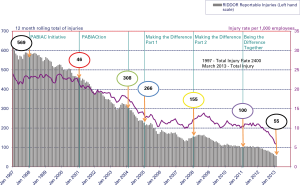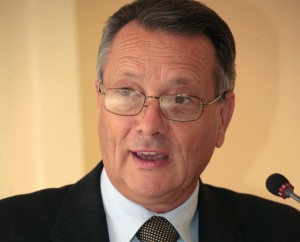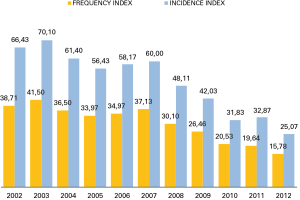The production of paper and cellulose requires the use of a wide range of resources: raw materials, energy, water and people, who are by no means a minor aspect being at the core of real competitiveness. Paper Industry World intended to investigate this major resource and to this end it has interviewed representatives of a number of European paper associations, specifically in Spain, Austria, Great Britain, Italy and Holland, to learn more about their way of developing a culture of health and safety towards the attainment of the “zero accidents” objective.
According to the Agency for Safety and Health at Work (EU-OSHA), about 5,600 casualties due to accidents at work and millions of injured people or workers with severe health consequences following an accident at work are registered every year (Source: Cepi). This tremendous data shows the pressing need to the face the issue from several points of view, last but not least from the point of view of «risk awareness». The real objective to avoid an accident at work namely consists in raising the awareness of both employers and employees on the risks connected to their various tasks and on how said risks can and should be managed in their daily activities, thereby creating a real health and safety «culture».
In order to provide guidance in this direction, Cepi (The Confederation of European Paper Industries) and IndustriAll (European Trade Union), presented a Report of Good Health and Safety Practices in the European Pulp and Paper Industry «No Paper Without Skilled, Healthy and Safe People» in 2012, i.e. a joint paper including well 22 best practises gathered among the companies member to Cepi and the European Trade Union with the support of the General-Directorate for Employment and Social Affairs of the European Commission: this is a tangible toolkit for H&S managers, as well as a working tool for H&S managers in European paper mills to significantly reduce the risks linked to work inside paper mills and reach the “zero accidents” objective. The specificities of the illustrated best practices provide guidance to all types of paper mills addressing the H&S issues linked to them and their different activities, like daily activities, transports, maintenance, etc. A constant reference to health and safety as fundamental values for the industry, taken into account also by individual professional associations which have been long working actively in this direction.
An overview of details and differences is provided by the interviews with the associations of five European countries, i.e. Spain, Austria, Great Britain, Italy and Holland. The interviews focussed on how associations are working to reach the “zero accidents”; i.e. on their recent specific initiatives, possibly in the form of prizes or competitions to motivate employees and businesses to increasingly behave in compliance with employee’s safety regulations, as well as on the strategy they have adopted to address this important issue.
Spain: safety for Aspapel
We talk about currently ongoing initiatives in Spain with Inés Chacón, Human Capital Director of Aspapel (Spanish Association of Pulp and Paper Manufacturers) based in Madrid. «In 2005, the Spanish paper industry launched a Sectorial Programme of Occupational Health and Safety, under which a range of projects have been and continue to be developed», says Inés Chacón. «The program, sponsored by the Spanish Association of Pulp and Paper Manufacturers (Aspapel) and the trade unions Fitag-Ugt and Fsc-Ccoo, began with the 2005 Diagnosis of the Status of Occupational Health & Safety in the Sector, which was reviewed in the project entitled HSE Diagnosis +5 in 2010. The initial diagnosis revealed a number of areas for improvement such as defining roles and responsibilities, preventive planning, safety inspections, training tailored to each job, the system of work permits, the adaptation of machinery to current legislation (RD 1215/97) etc. To cover these needs, a series of projects have been launched, all with the support and funding from the Foundation for the Prevention of Occupational Hazards or the Manual of Observation of Safe Behaviour (2010), funded by the Industrial Observatory of Paper Sector of the Ministry of Industry, the Safety Manual in Stockage of Raw Materials and Finished Products and a Diagnosis of Ergonomical Risks in Paper Industry.»

Projects implemented in Spain and ongoing projects
- The Model Guidelines for H&S Management Systems (2005) provides companies in the sector with clear guidance on how to address prevention management and what tools to use to boost a stronger prevention philosophy in daily life at the mills with the aim of affording greater control over the hazards involved in the business. To implement the Guide, which is kept permanently updated, a number of technical assistance programs for companies have been developed.
- The Manual for Improving Safety in Paper Machinery (2006) provides the industry with a wide range of solutions to address the problems of adapting its machinery to the provisions of Royal Decree 1215/97 (implementation of Directive 89/655/EEC dated 20 November and EC Directive 95/63/EC of 5 December), which represent a benchmark in the sector based on the consensus of technical experts from the industry, manufacturers of papermaking machinery and specialist consultants that all participated in the project.
- Audiovisual Catalogue of Critical Situations (2009) is an innovative training tool specifically designed for the sector. It focuses on those operations considered to entail the highest risks in the paper industry and on those situations where the most serious accidents take place. These particularly hazardous operations are grouped into five areas: working at heights, working in confined spaces, allocation of equipment for maintenance and cleaning work, working with chemicals and hot work. However, the catalogue is not limited to providing a repertoire of especially hazardous situations but also describes in detail the preventive measures to be taken in each case to avoid accidents and illness associated with such risky operations. They say a picture is worth more than a thousand words. That was the thinking behind the choice of a visual format, given the power of audio-visual tools for catching and holding the audience’s attention. In addition, the catalogue includes the procedures that determine the method for issuing work permits for such operations as well as training videos on the subject.
- The Manual of Observation of Safe Behaviour (2010) seeks to create a true culture of safety, putting the focus on safe behaviour to encourage and create consolidated awareness about prevention.
- The Safety Manual in Stockage of Raw Materials and Finished Products (2011) provides companies in the sector with clear guidance in this area, which is not specifically legislated.
- After the HSE Diagnosis +5 developed in 2010 it was necessary to identify the main ergonomic risks in paper industry, as overstrain was included in the causes of the 25% of lost time accident. The Manual of Ergonomical Risks in Paper Industry (2012) shows that there are no important ergonomic risks in our industry and that the main ergonomic risks mainly appear in the converting areas.
- We are developing a Manual to help companies in Psychosocial risk assessment and in 2014 we are going to prepare, with the support of the Spanish Foundation for the Prevention of Occupational Hazards, a Manual of the Best Occupational H&S Practices in the Spanish Paper Industry, focused in five areas.
Improved frequency and incidence rates
An intensive activity requiring a lot of efforts, which were all extremely successful: «The projects carried out in the last eight years have had a lot to do with the improvement in accident frequency rates in the sector, which went down from 36.5 in 2004 to 15.78 in 2012, while incidence rates dropped from 61. 4 in 2004 to 25.07 in 2012. The objectives of the Sector’s Programme for the Prevention of Occupational Hazards have been set out on the basis of the needs identified throughout the sector, so that the various projects undertaken have provided businesses with genuine work and consultation tools developed with their own active participation.
The Technical Forum, organized as part of the Programme and in which 60 technicians in the Prevention of Occupational Hazards from 40 companies in the sector participate, has become the foremost channel for sharing information, resources and experiences in this matter.
Such participation and collaboration by all stakeholders is a fundamental principle of the Spanish paper industry’s Programme, in consonance with the spirit of the recently launched European Social Dialogue between Cepi (Confederation of European Paper Industries) and Emcef (European Mine, Chemical and Energy worker’s Federation), which considers the Prevention of Occupational Hazards as one of the main issues to be tackled in joint collaboration. Two of the Spanish projects were included in the Report of Good Health & Safety Practices in the European Pulp and Paper Industry in 2012».
Aspapel: A highlight of the main achievements of the program is the development of sectoral benchmark criteria, the significant involvement of enterprises, co-operation between businessmen, unions and workers, and the important work carried out to distribute and communicate the end results.
Austropapier: A working group in Austria since 1987
Werner Auracher (Austropapier, the Association of the Austrian Paper Industry) talks about how the Austrian association managed the safety issue: «In the Austrian Papier industry a working group with experts from mills was established in 1987 and has been working since then 2. There is an intensive cooperation with the Auva (Austrian Accidence Insurance) regarding prevention, with unions and with other sectors like paper converting industry, too. Once in a while we organize mill visits with our safety experts in other industrial sectors to enlarge our horizon concerning safety (for instance, we had a visit in a steel producing and waste incineration plant). Since 1993 accident rates in our mills have decreased by 82 % 3. Nevertheless, the target set by the working group is a zero accident rate. In the past years several mills had such a performance, which proves, that such a goal is not unrealistic at all».

The initiatives at mill level
In addition to what is done on association level there are also initiatives on mill level: «Such as seminars with external experts or with the accident insurance association, the are various ranging from unsafe behaviour to the prevention of mental illness or leadership skills. Some mills have introduced a Safety Day once a year with a special focus on certain aspects of safety and presentations from external experts. Each mill has a safety expert, who is in charge of this issue». Of course, there are differences between mill sites depending on various factors such as culture, awareness of the management, ownership: «Some of our mills have been more successful than others in reducing accidents or have even reached zero accident rates in some years. It is difficult to keep such a high standard with regard to a very challenging economic environment with cost cutting measures and job losses in same cases». Yet the most important factor should come from the example provided by managers: «Safety at work is a management task. This is the most important factor, the awareness for safety has to go top down. The management has to behave in an exemplary manner in terms of safety. For example, if there is an obligation to wear a helmet on a mill site and a CEO visiting the mill does not keep to it, it stands to reason that the worker himself will not take it seriously either. All mills with a good safety performance have a management which sets an example and has integrated the safety philosophy in their everyday life».
«Arbeitssicherheitspreis»: a prize for the best performance
The mills with zero accidents and the best performance on safety in the previous year is also awarded with the safety prize «Arbeitssicherheitspreis» and a certificate in the course of a celebration act at the «Papierfachtagung» in Graz. This is organized by the Özepa (Association of the Austrian Paper Technicians and Paper Chemists). The improvements are obvious and can be seen in the development of the work accident rate 4.
Tools developed by the working group
Statistics: Austropapier has a comprehensive statistics about accident rates, number of absence days due to accidents, number of accidents to and from work, near misses and dangerous occurences. Moreover, a precise description of the accidents, the reasons and the measures taken or recommended are given on the Web platform and are discussed intensively in the working group.
ASI-Audits: The safety experts have reached an agreement that each mill has to be audited and each mill should offer their safety experts for an audit in another mill once a year. So the experts can learn from each other and exchange their views and experiences.
Contractors: To avoid accidents and unsafe behaviour from workers coming from outside, which is very often the case especially during repairs or investments, training for contractors in the safety regulations on the mill site is obligatory. If contractors do not comply with the rules, their contract will be canceled.
ASI-DVD: A safety DVD has been developed as a training tool for employees, visitors etc.
At the moment Austropapier tries to implement voluntary safety lessons both in one engineering school as a project and in the curriculum for paper technician students at the technical university in Graz to raise awareness already at this eary stage.
CPI: a long way since 1997
Andrew Braund, Director of Health, Safety and Social Affairs Confederation of Paper Industries (CPI), tells about UK Paper Industry Health and Safety in United Kingdom, going back a long way to understand where the UK paper industry has come from to where it is today: «In 1997 the UK paper industry suffered from an accident rate that was consistently twice that experienced by the rest of manufacturing and a fatal and major accident rate in excess of the construction industry. From Jan 1998-Dec 98 we had 2 Fatalities a total of 52 major injuries, some of these were life changing injuries (amputations) and 496 other reportable injuries. In one year a total of 550 accidents were reported in UK paper mills. And this was the tipping point for change. At a high level, the Health and Safety Executive (HSE, UK enforcement for H&S), Government Ministers and the Trade Union were questioning the industries appalling accident rate.
The CPI (or Paper Federation of Great Britain) as we were known back then, could not defend the indefensible, and the pressure was on from all parties for the industry “to do something now or else!”. There was a real threat that if we did not change, paper machines would be prevented from operating, and as a consequence there would be no production.
There were a number of immediate challenges firstly, guarding. As an industry we didn’t guard paper machines Employees were being exposed to fast running paper machines on a daily basis with little or no protection. Secondly – Safety Culture and Management Depending on the paper mill – both the culture and the management attitude to safety was variable».
«How do you begin changing an industry?»
«The big question is how do you begin changing an industry, especially one with deep traditions and practices and “us and them” attitudes? We already had industry guidance, but hardly anyone was using it. A more direct approach and one that worked for us, is to convene a meeting of all the Chief Executive Officers, and Managing Directors, and tell them they had to change, because unless they were prepared to change they would feel the full force of the law, and full enforcement means: regular unannounced site visits; improvement / prohibition Notices being served where appropriate; paper machines being shut down; prosecutions and heavy fines.
Every UK paper mill had to submit an H&S action plan, these were time bound and monitored. «An industry target was set to reduce the number of reportable injuries by 50% over a 3 year period and to change the culture in the industry. CEO’s and MD’s went away from that meeting knowing full well that this was not an idle threat. The time had come for change, but they needed support and guidance. The support came through, the HSE, the trade unions and above all the trade association. To bring about change you need employers and employee ALL working together towards a common goal. The guidance came through Making Paper Safely (MPS). This industry specific document changed the way in which paper was made in the UK. No longer could employees be exposed to moving parts of machinery, everything had to be guarded, and robust safe operating procedures were introduced. This single document set the foundation for the next 15 years.
Since then, and using the format from MPS, the UK paper industry has continued to write industry specific guidance. We have guidance on reeler and slitter machines, fire prevention in paper mills, we have produced our own climate survey and safety management tool, there are a number information sheets relating to noise, occupational health, isolation and lock off procedures, securing and transporting paper products to name a few».
All stakeholders working together
«From the beginning, it was imperative that to change an industry you had to have everyone working together. Very early on in the programme; HSE, the Trade Unions and the Employers Federation (CPI) agreed that each of the partners had a key role to play. This ‘tripartite’ work is undertaken under the auspices of the Paper and Board Industry Advisory Committee (Pabiac).
Transparency and Openness: HSE agreed to share details of initiatives and campaigns in advance, Inspectors would work with paper mills on their action plan.
- CPI organized seminars, facilitated workshop to help industry find solutions to MPS and share information. We arranged regional H&S meetings, a practice that continues to day. These meetings allow paper mill representatives to come together, without fear of competition law to talk about all matters health and safety related. Meetings are hosted by a paper mill, and will often include a mill tour as part of the visit. Feedback at the end of the tour is often forthcoming and greatly received by the host.
- For the first time CPI started to record injury statistics on a monthly basis. This practice continues today and is a good measure of how well (or badly) we are performing Each paper mill submits to CPI their injury figures for the preceding month along with details of any accidents, these are then circulated across the industry.
- As the industry has matured over time, we now include near miss data and other proactive measurements. One of our Key Performance Indicators going forward is to get more companies to increase their level of near miss reporting. There is good evidence that pro-active near miss reporting, with a good system for acting upon them will reduce accidents. Within the papermaking sector alone. CPI Members reported over 27,000 near miss reports last year, an increase of 15% on the previous year. And I strongly believe that this is just the tip of the iceberg.
- The Trade Union increased training for safety reps. They introduced «Say No» to working unsafely and worked with industry on introducing immediate action guidelines. These were incorporated into the National Agreement and are still part of that agreement today.
- Four years ago CPI and Unite the Union revisited this, and launched a joint campaign called ‘Say Yes, Say No’.
UK Papermaking Sector Injury Rate
«For a number of years, the Papermaking Sector had struggled to consistently break through the 1,000 injuries (per 100,000 employees) level. At the start of January 2012, the sector’s total injury rate was 1,105; in May 2012, the sector recorded a sub 1,000 injury rate for the first time in five years. Following successive month-on-month improvements, by December 2012 that figure reduced further to 695. Today that figure now stands at 568. Since 1998 the industry has continued to improve its injury rate, and under each of the PABIAC phases there is evidence that having in place, a strategy with clear objectives, within a deliverable time frame, can contribute to that downward trend (see picture here under)».

Paper and Board Industry Advisory Committee (Pabiac)
«CPI works in partnership with the Health and Safety Executive (HSE) and trade unions, through the Paper and Board Industry Advisory Committee (Pabiac). The role of PABIAC in helping the industry to achieve its current status, and to continually set challenging targets today cannot be under estimated. We are very highly regarded in the UK and are often used as an exemplar to other industries. There is now only a handful of Independent Advisory Committees left in the UK, which is testament to all of the work that the industry has done.
One of Pabiac strengths has been its ability to adapt over a number of years to industry needs and a changing economic climate. In 2005, Pabiac moved away from imposing strict targets on the industry, to one that operates as a strategic delivery partnership. The current strategy is set out in «Being the Difference Together 2012 -2014. The mechanism for delivery of targeted outcomes is illustrated at Appendix 1 of «Being the Difference Together». Essentially, Pabiac sets the strategic targets and these are then taken forward by way of specific objectives prepared by CPI’s Industry Delivery H&S Committees».
Italy: the «Zero objective» prize awarded by the Lazzareschi Foundation
The «Zero Objective» Safety Project has been implemented in Italy for a few years. It is the brainchild of Angelo Del Carlo, director of the Giuseppe Lazzareschi Foundation, in collaboration with Assindustria Lucca, the local health company Ausl, Inail and the Università di Pisa and is supported by Assocarta (trade organization regrouping and working on behalf of the Italian Paper Industry representing pulp, paper and board manufacturing companies in Italy).
The aim of the project is to raise the awareness on and promote the culture of safety at all levels by rewarding those companies, which over the year have registered the best performance levels as regards accident frequency and severity both in absolute terms and in terms of relative improvement. Worth highlighting is furthermore the possibility to involve paper mills employees through the certification of the number of working years spent without registering any accident.
Over the years this initiative has enjoyed remarkable success and acknowledgement by the public institutions and bodies responsible for safety at work and in 2014 it was supported by the President of the Italian Republic, who expressed his acknowledgement by sending a medal to the President of the Lazzareschi Foundation as a representation prize awarded by the State’s highest authority to the the Zero Objective objective. Angelo Del Carlo provides us with more detailed information: «public opinion tends to think of an enterprise as a place where safety is not included among the entrepreneur’s priority objectives, profits are the most important factor of all and it is all too easy to receive physical damage and in some cases even death or permanent disability. The project was thus created also with the aim of providing an answer to these safety issues.»
A «healthy» competition between companies
Zero Objective rewards those companies, which registered the best obtained index (i.e. the lowest number of accidents per number of hours worked), the best severity index (i.e. the lowest number of sickness leave hours due to accidents compared to the number of hours worked) and the best frequency rate (i.e. the lowest number of accidents per hours worked in a year by all employees of the company). The project thus rewards those companies, which registered the lowest indexes and improvements, i.e. the good will, improvement and committment of the company.
The Lazzareschi Foundation issues an attendance certificate to each company and a trophy, a special certificate to all the companies, which closed the year with no accidents and reached the «zero accidents» objective, as well as certificate of merit to all the companies standing our for their results. Furthermore, each company provides the names of its employees, who have not been suffered from accidents for at least ten years in a row and subsequent five-year intervals: the Lazzareschi Foundation issues a certificate of merit to these companies, as well.
Finally, the «More for zero» award is destined to those enterprises showing a lot of ideas and implementing particularly virtuous and interesting practices, which can be taken as an example by others, too. This strengthens the idea that safety is not an issue of competition, but rather an aspect raising in everyone the interest to improve their own safety and the safety of their company.
The aim of Zero Objective
- Spreading the culture of safety
- Raising the awareness of companies and employees to reach increasingly high levels of safety
- Informing public opinion that companies’ efforts aim at reaching increasingly high levels of safety in the working environment and showing the safety results and levels obtained in paper mills

VNP: a wide variety of initiatives in Netherlands
Gerrit Jan Koopman tells about VNP (Dutch association of paper mills): «We do have a wide variety of initiatives that encourage paper mills to work on safe behavior with their employees. VNP cooperates with two other associations (the Dutch corrugated board association named “Vereniging Golfkarton” and the association for producers of packaging materials named ‘Kartoflex’), three labor unions and the Dutch Government & Safety Inspection Agency on our safety programs since year 2001. Initially we worked on a covenant that helped us to agree on a common approach for all parties involved. The covenant included establishing a common vision on safety, developing tools and organizing meetings to promote the safety message and supporting programs. This all lead us to a situation of self-regulating. There is an ongoing dialogue between the associations and labor unions, which strengthens the ambition to improve safety on an ongoing basis.
VNP has set up a committee of safety managers from all plants, who meet 4 times per year. The individual companies share good practices within this committee and also cooperate on annual themes such as fall prevention and Lockout Tagout Tryout (2013). The good practices available have been posted on a dedicated Website as a catalogue for all companies involved».
About the awards, «VNP has an annual safety award which gives recognition to the plant with the best improvements made on safety. Not only the incident rate counts, but we also monitor the progress made during the year by the teams involved.
About the incident statistics, «We collect incident statistics from our members every quarter. We also communicate incident alerts with a brief description of the incident, a picture of the situation and recommendations for solving the underlying causes. This is being communicated as ‘it can happen to you…’ alerts».



